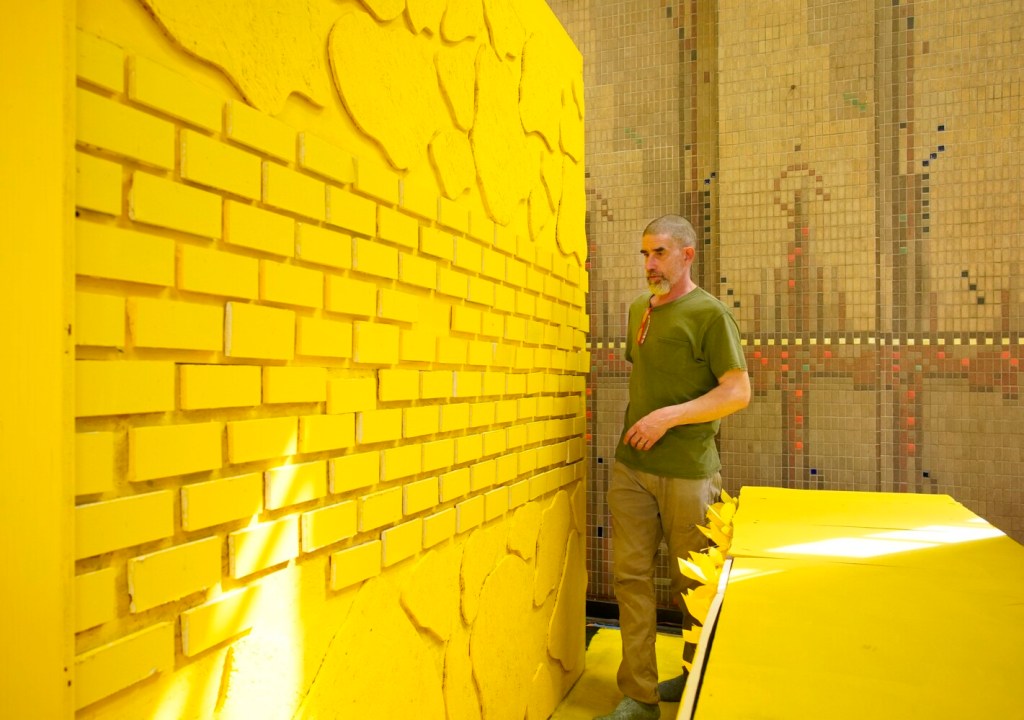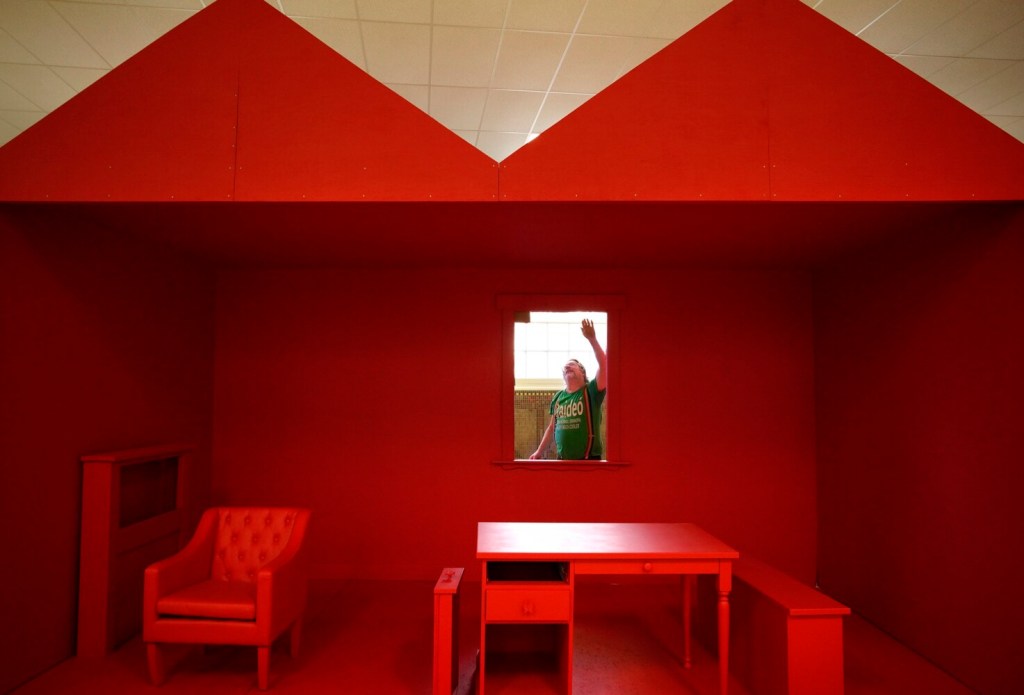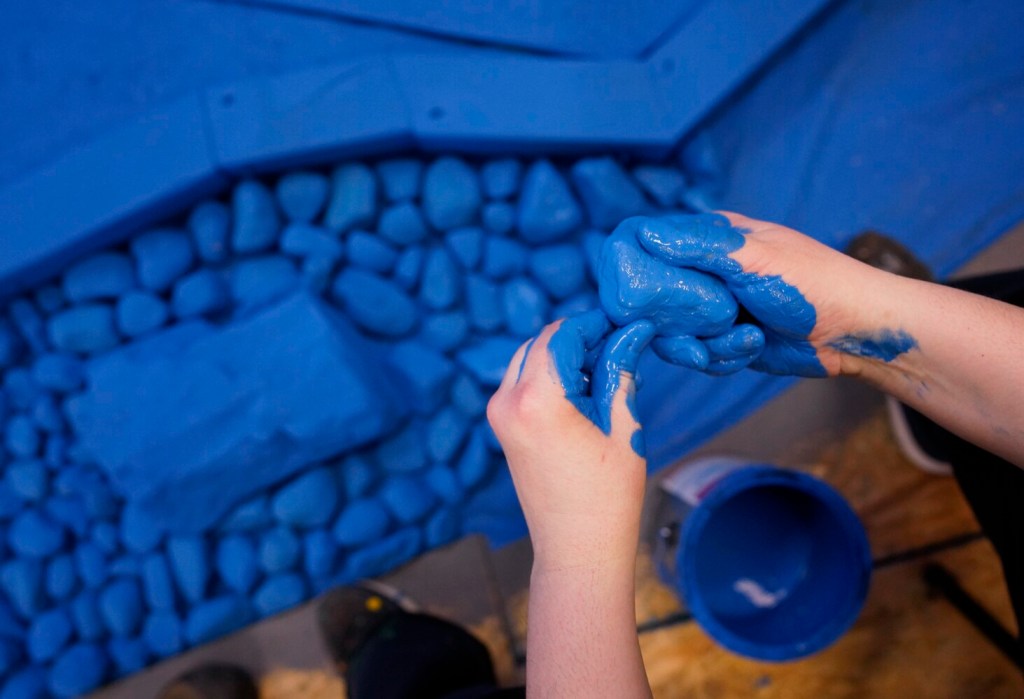WESTBROOK — Amy Stacey Curtis picked up the rock and dipped it into the plastic bag filled with brilliant blue paint. She pulled the stone out and rolled it in her hands until all sides were coated. Then she placed it gently down with dozens of others like it and started again.
“This is what I love to do,” she said. “The repetitive process of painting and placing these rocks. This is my favorite part.”
Curtis, an installation artist and current artist-in-residence at the University of Southern Maine, spoke as she worked to finish her latest, and perhaps most ambitious, piece. That’s saying a lot for an artist whose trademark is large-scale work, including a series of massive installations over an 18-year period inside abandoned mills across Maine.
The venue this time is the former Westbrook High School, now Presumpscot Commons, a senior housing complex managed by the city’s housing authority. The space was perfect for two reasons. Curtis could use it free of charge, and it fits with the project’s theme: memory.
“There are people who live here who have a lot of memories, and of course the building itself was built in 1886. We’re surrounded by memory,” she said.
The installation – which opens to the public Saturday and runs through April 22 – features a neighborhood of nine distinct houses, each the size of a shed, each a distinct color. Everything accompanying the house, inside and out, matches that color. Blue rocks, for instance.
Like her other work, the installation will be interactive. Inside each house will be a desk and a chair with a blank book.
“The concept was I invite each audience member to write in the book a memory that the respective color makes them think of,” Curtis said. “So, when you’re in the red room, what memory does the color red make you think of?”

Michael Shaughnessy cuts cardboard being used as housing shingles on the back of the red-themed house. Gregory Rec/Staff Photographer
Unlike some of her other installations, Curtis has turned over a lot of the work to dozens of USM students who have assisted over the last several weeks. Some of that has been necessity. For the past five years, the 51-year-old artist from Lyman has been recovering from a brain injury that left her, at various points, bedridden, needing to use a wheelchair and fighting back suicidal thoughts. She has developed movement and speech disorders, too, which doctors now believe were caused by untreated Lyme disease.
“She’s phenomenal. My students have really taken to her,” said Michael Shaughnessy, a longtime art professor at USM who also lives in Westbrook and serves on the City Council. “And this is great for them because it reminds them that growth doesn’t always manifest in objects. Growth happens through experiences.”
Sara Colantuoni, one of the students who has worked with Curtis, said the experience has been transformative.
“I was amazed at how huge it was,” the second-year student from Berwick said. “As an artist, I’ve really only done things small scale and nothing interactive like this.
“Her installations really bring the community together. There are a lot of interpretations for people who are artists and people who aren’t when they look at this piece.”
Curtis already had the idea for the installation “in her back pocket,” when she was selected last year to become USM’s artist-in-residence.
She wanted to build off another installation she did many years ago that involved 99 white desks set up in neat rows with a book on each surface representing a year. Each person who participated was asked to write a memory in a book that corresponded with the year of that memory. The installation was called “memoir I.”
For “memoir II,” Curtis envisioned using color to evoke memories – nine spaces, each a wholly different color. When she settled on the space, a former gymnasium-turned-activities room, the piece evolved. There was a rug on the floor that couldn’t be removed. That meant Curtis had to cover it will plastic, which also meant she needed to incorporate the floor somehow into the artwork.
“So instead of nine spaces, I’m building nine houses and they’re on a cul-de-sac. It’s a neighborhood now,” she said.
Each colored house will be unique and, in some cases, inspired by people in Curtis’ life. The green house, for instance, was modeled after the home of her husband’s parents.
“I’ve always loved their house,” she said. “It’s very New England country. They have mulch and cute plants and metal paint cans with flowers growing out of them and a fire pit. It’s just sweet.”

The orange-themed house was inspired by the late husband of a woman Curtis knows and is filled with some of his belongings. Gregory Rec/Staff Photographer
Another house was inspired by a woman she met in a writing class. The woman’s husband, who had recently died, was something of a hoarder.
“We were at a session one day, and she knew what I did and asked if I wanted any of his stuff,” Curtis said. “It happened to coincide with this project, so a lot of the objects in that house are actually things that were his.”
A crate full of bottle caps. Another filled with rubber duckies. All painted orange.
The white house is modeled after the artist herself.
“That house is going to have grass that hasn’t been mowed in years and leaves that haven’t been raked and acorns that haven’t been picked up,” she said, her words giving way to a laugh, then a full-blown cackle.

Curtis laughs while talking with Donald Hughes as the two work on her latest installation piece at Presumpscot Commons in Westbrook. Gregory Rec/Staff Photographer
The imagined inhabitants of the yellow house are introverts, so they have a giant wall of hedges, which also help separate it from the orange hoarder house. The pink house residents are really into lawn ornaments. At the light blue house, they raise chickens.
“Unlike all my previous work, there’s all this added context,” Curtis said. “One reason my work is minimal is because I don’t want to add that context. I want people, within the simple forms and ideas I’ve created, to bring to the work things are going on in their own lives. That’ll be true here, too, but they will see other things. Like chickens, that might spark a memory.”
In all, Curtis said, she used at least 93 gallons of paint.
The final element will be a monochromatic photo montage playing on a loop on a screen inside each house.
Shaughnessy said USM’s artist-in-residence program has been in place as long as he’s been a professor – more than 30 years – and it’s always a great experience for students. Curtis, though, brings something else.
“Her work carries with it the angle of mental health, something she’s been open about,” he said. “She’s the poster child for persistence and engagement.”

Donald Hughes fixes small pieces of sheetrock arranged to look like bricks on the yellow-themed house. Gregory Rec/Staff Photographer
It hasn’t always been easy. Curtis worked many 14-hour days ahead of the installation opening to get every detail right. She credits her husband, Bill, for being her “number one art assistant,” but said the help she’s gotten from students has been invaluable as well.
Her illness hasn’t affected her concepts, she said, just her stamina.
“I can’t do it all, but I still have these big ideas, and I don’t want to lose those,” she said.
“The scale of this piece and the truncated amount of time to install it, I know I have to let go of a lot,” Curtis added. “If I don’t finish everything … I feel OK with that. I’m just going to do my best, ’cause the show opens whether it’s done or not.”
She let out another laugh.
Colantuoni, the student, said she’s gotten plenty from Curtis in return for helping.
“We had a lot of conversations and she asked about my goals as an artist,” she said. “We talked a lot about how hard it is to be an artist, especially in the state of Maine. And she was talking about her installations and about how other artists have helped her in the past. It was really beautiful.”
Shaughnessy, a sculptor by trade who has developed his own art installations, has been familiar with Curtis’ work for years but believes her current work will end up being a “stand-out piece.”
Curtis said it’s too early to think about where this piece fits into her oeuvre.
“It’s literally unfinished and static unless it’s being interacted with,” she said.
Send questions/comments to the editors.








